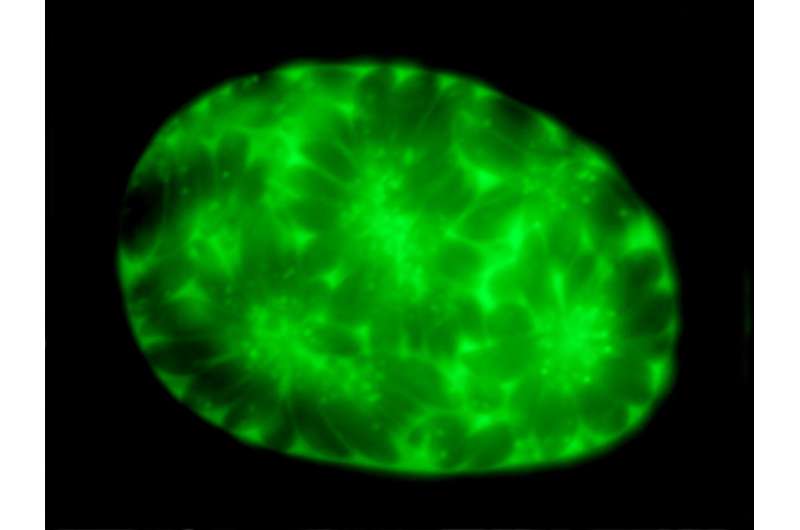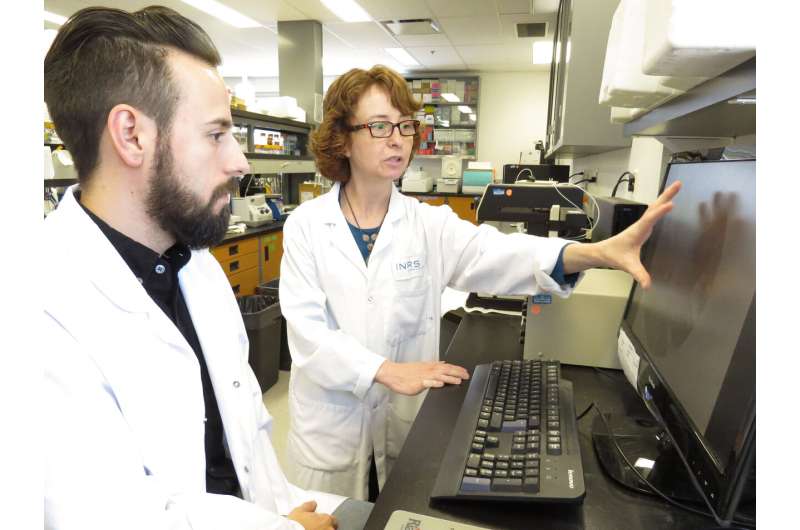Toxoplasmosis: Preventing mother-to-child transmission

Professor Maritza Jaramillo knows a thing or two about parasites—she has spent most of her life studying them. "During my bachelor's degree in Colombia, I did an internship at a lab specializing in parasitic infections. I was amazed by the range and complexity of the survival strategies developed by single-celled parasites. Then I realized what I wanted to do for the rest of my life!" says the researcher, who has been working at the Institut National de la Recherche Scientifique (INRS) since 2012.
Professor Jaramillo and her team—research associate Dr. Louis-Philippe Leroux and Ph.D. student Visnú Chaparro—are studying Toxoplasma gondii (or T. gondii), a single-celled parasite that infects warm-blooded animals including one third of the world's human population. The parasitic infection caused by T. gondii is called toxoplasmosis.
"I am passionate about studying how this parasite survives within the host because it is extremely adaptable and resilient. It can colonize approximately 350 host species, infect almost every type of nucleated cell, and has a whole arsenal of weapons," says Professor Jaramillo. "I'm like a kid in a candy store—there's so much to discover!"
T. gondii can be transmitted through the ingestion of contaminated raw meat, vegetables, soil or water. The parasite is well known for being transmitted to humans through contact with contaminated cat feces or litter and for the risks it poses to human fetuses.
Helping women
Professor Jaramillo's lab focuses on how the parasite is transmitted from pregnant women to their babies. Her team has received recently a $700,000 grant from the Canadian Institutes of Health Research (CIHR) to study the underlying molecular mechanisms of this transmission and investigate how the infection affects placenta development and functions.
When a pregnant woman contracts toxoplasmosis and the parasite is transmitted to the fetus through the placenta, it's referred to as congenital toxoplasmosis. In such cases, a T. gondii infection can lead to a miscarriage, premature birth, or cause serious birth defects such as blindness, hydrocephalus, and mental retardation.
Doctors still do not know how to prevent the parasite from being transmitted to the fetus.
It is estimated that over 90 percent of women of childbearing age are at risk of contracting toxoplasmosis. Professor Jaramillo points out that, unfortunately, there are still no effective vaccines for toxoplasmosis and the available treatments often have harmful effects on the fetus (birth defects, etc.).
"The rate of T. gondii infection is very high in some South American, African, and European countries," says Professor Jaramillo. "In Canada's far north, especially among First Nations communities, the prevalence of the infection has reached 60 percent which is largely attributed to the consumption of infected raw meat from terrestrial and sea mammals."
RNA: Behind the scenes
Professor Jaramillo's team is the only group in Canada seeking to understand how the disruption of the host RNA metabolism and protein synthesis during T. gondii infection contributes to the dysregulation of placental cell function.
"Several research groups are studying how gene expression is altered due to aberrant synthesis of RNA from DNA in T. gondii-infected cells. What interests us is what happens next, i.e., defects in the stability and translation of RNA that lead to inadequate protein production," explains Professor Jaramillo. "We're focusing on RNAs that encode proteins involved in the metabolic activity and inflammatory responses of infected cells because changes in these processes may play an important role in the pathogenesis of congenital toxoplasmosis."
The project involves the use of human placental cells, called trophoblasts, which are essential for embryo implantation and fetal development. The researchers will infect the cells with T. gondii and observe changes in RNA stability and translation.

Through a unique collaboration with CHU Sainte-Justine and Université de Montréal, the team will also have access to placental samples from pregnant women infected with T. gondii to verify if what they observe in the laboratory also occurs in infected individuals. Using placental tissues from non-infected donors, they will also be able to mimic the architecture of the placenta in an ex vivo model and study the changes that occur in the entire placenta.
"These valuable resources will help us validate our in vitro results and directly assess the implications of these discoveries in a clinical setting," says Professor Jaramillo. "One of our major strengths is the multidisciplinary character of our team. We are indeed very fortunate to collaborate with an excellent and diversified network of researchers from Karolinska Institutet, CHU-Sainte-Justine, Université de Montréal, Université de Sherbrooke, and INRS."
"It's been my dream to secure funding from the CIHR—it is definitely a seal of approval for a researcher working in biomedical sciences here in Canada. Now we can really start having fun doing beautiful science" says Professor Jaramillo.
The team's long-term goal is to better understand the biological mechanisms involved in congenital toxoplasmosis and to pave the way for safer treatments to prevent the transmission of T. gondii during pregnancy.
"I come from Colombia, a very disadvantaged developing country. So as a South American and a woman, I have a vested interest in improving the health of people in my country and especially the most vulnerable populations such as women and children," concludes Professor Jaramillo.



















